The snatch is a challenging Olympic weightlifting movement that requires strength, power, mobility, and high amounts of technique.
In this article we will discuss three (3) common snatch mistakes beginners, CrossFit athletes, and even experienced lifters make when snatching that can be detrimental to their overall success.
- 3 Common Snatch Mistakes
- Exercises to Improve Common Snatch Mistakes
- How to Integrate Snatch Solution Exercises
Be sure to check out our Snatch Guide to review the key concepts and technical aspects of the snatch.
1. Hips Shooting Up in the Pull
Many lifers will lose positioning off the floor in the snatch (and clean), often due to trying to yank upwards onto the bar to accelerate it into the pull. If a lifter’s set up is incorrect, it can often send their hips shooting upwards, the balance shifting forwards, and create a slew of compensation mechanisms that will result in either a missed lift or technical errors.
Below are three snatch variations and accessory movements coaches and athletes can use to improve a lifter’s positional strength and awareness in the pull of the snatch, as well as help to stay balanced in the pull.
Pause Snatch
The pause snatch is a snatch variation that has a lifter perform a pause at some point throughout the pulling phase. This often is done either below the knee or just above the knee at the low thigh.
The goal of the pause is to increase isometric strength and coordination specific to the positions needed in the snatch pull, while also allowing coaches and athletes to pinpoint specific areas at which the pull breaks down.
Start by performing 3-5 sets of 2-3 reps of paused snatches (from the hang or floor), pausing 2-3 seconds each rep. Start with 60% of your snatch max and build.
Slow Snatch
Similar to the pause snatch, the slow snatch is done to allow a lifter to feel the positions of the pull and to help diagnose at what point the hips shoot up, balance shifts forward, and the technical issues begin.
Initiate the snatch pull, almost in slow motion, taking 2-4 seconds to consciously slow the pull down. Once the bar reaches the high thigh, shift into full speed and finish the snatch.
Start by performing 3-5 sets of 2-3 reps of slow snatches using 60-70% of your max, and build.
Deficit Snatch Pull
The deficit snatch pull is a snatch pull, however the lifter is standing on plates or a 1-2 inch raised platform. In doing so, you increase the range of motion of the pull, placing greater emphasis on the set up positioning and leg drive.
This exercise will work the hamstrings, lower back, and positions necessary to keep the hips from shooting upwards in the snatch.
Start by performing 3-5 sets of 3-5 reps of deficit snatch pulls using 70-80% of your snatch max, and build.
2. Swinging the Barbell Out Front
Barbell looping, also known as swinging, is often created by a lack of vertical extension of the body. Many lifters will unload the hips onto the barbell, forcing the bar to bounce forwards off the hip and create a large, arcing movement of the bar. This ends in a large “S-Curve” motion, which impacts the receiving position of the snatch.
To fix this, the lifter must first understand the sum extension forces that are in play during a snatch. Both the knees and the hips must extend together and at the same rate to produce a vertical movement of the barbell while minimizing horizontal displacement.
Additionally, the lifter must then extend the torso and pull upwards onto the bar (after extension) with the elbows high to provide additional guidance and upward force onto the bar before pulling under into the squat position. Below are three snatch variations and exercises coaches and lifters can do to improve vertical extension, reinforce upper body engagement in the snatch, and improve barbell trajectory.
Hip Snatch
The hip snatch is a snatch variation that emphasizes the final explosion phase of the snatch. To do this, the lifter starts in the standing position with the barbell in the hip crease. The lifter will perform a short bending of the knees (1-2 inches) while keeping the arms straight, torso vertical, and bar in the hip crease. They will then violently stand upwards and perform a snatch, not allowing the chest to get pulled forward at any point in the movement.
Start by performing 3-5 sets of 2-3 reps of hip snatches using 65-70% of your snatch max, and build.
Block Snatch
The block snatch is done by setting a barbell on a pair of drop blocks, often so that the bar starts above or just below the knee. This, unlike the hang snatch, allows a lifter to get set up and reinforces proper balance in the snatch pull without adding fatigue (in the hang position the lifter must support the load longer). This means the lifter can spend all their energy achieving proper positions and power.
Start by performing 3-5 sets of 2-3 reps of block snatches using 65-70% of your snatch max, and build.
Muscle Snatch
The muscle snatch an exercise that can help a lifter develop the necessary strength, timing, and barbell trajectory for performing snatches. In beginner and intermediate lifters, the muscle snatch can be integrated within warm-ups, main snatch work, and accessory training to increase overall muscle mass, control, and vertical extension capacities of a lifter.
For more experienced lifters, the muscle snatch can be used to improve aggression during the pull and turnover phases of the snatch while also increasing power.
Start by performing 3-5 sets of 3-5 reps of muscle snatches using 40% of your snatch max, and build.
3. Weight Crashing Down On You
The snatch is a great exercise for developing power and is a beautiful example of strength, athleticism, mobility, and precision. In the situations where the snatch is crashing down onto a lifter, it’s often an indication of poor timing, lack of finishing the extension phase, and/or limited overhead strength.
Below are three exercises and snatch variations you can do to increase overhead strength, timing, and extension capabilities.
Tall Snatch
The tall snatch is a snatch variation that can be done to increase the timing and upper body mechanics following the full extension of the snatch pull. Often, lifters will be in a hurry to get underneath a snatch, often “diving/dropping” underneath the snatch rather than pulling under.
Lack of the third pull (which is what the tall snatch addresses) often results in the lifter diving their torso forward to save lifts, the lifter receiving the barbell overhead with bent elbows, and/or the lifter not feeling fast and confident in their abilities to pull themselves underneath a heavy snatch.
Start by performing 3-5 sets of 3-5 reps of tall snatches with the empty barbell, and build up in weight slowly. They key here is speed and precision.
https://www.instagram.com/p/ByeAHGaAaD9/
Snatch Balance
The snatch balance is a snatch accessory exercise than can be used to increase both overhead strength, overhead squat abilities, snatch footwork, and timing underneath a heavy snatch.
Generally speaking, a lifter should be able to snatch balance 105-110% of their best snatch. If they cannot snatch balance that amount of weight on a routine basis, this may suggest poor overhead strength, lack of control and confidence underneath heavy snatches, and decreased speed underneath the bar.
Start by performing 3-5 sets of 2-3 reps of snatch balances with 80-100% of your snatch, working to be able to snatch balance 10% or more than you can snatch.
Overhead Squat
The overhead squat is a staple strengthening exercise for the snatch. Lifters who visibly struggle to assume a low and stable position in the overhead squat or underneath a snatch typically can benefit from including pause squats assuming they use the same snatch grip, foot position, and depth the do when attempting a snatch. Lack of mobility and overhead strength often can lead to shoulder, back, elbow, and wrist injury.
Start by performing 3-5 sets of 2-3 reps of overhead squats either from the rack or adding them into snatch complexes.
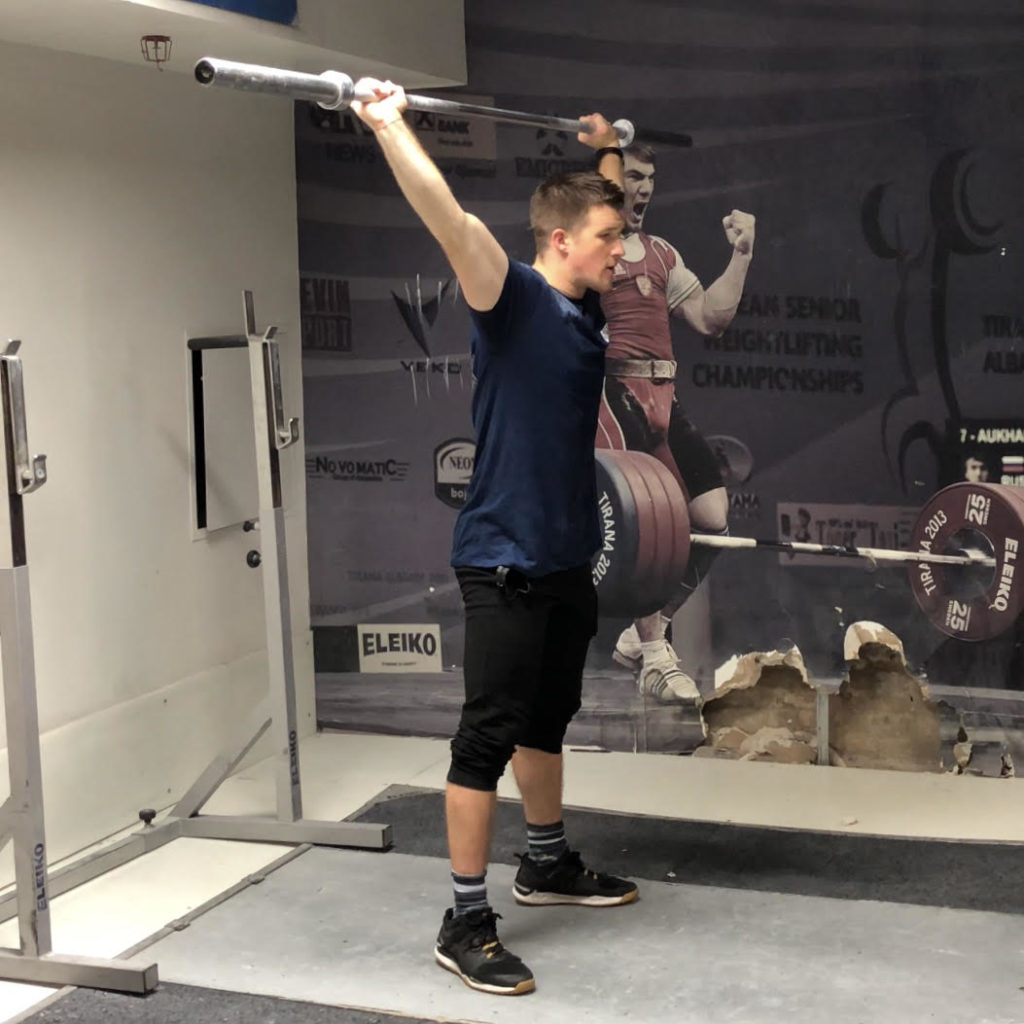
1.
Establish Position
Start with the barbell placed overhead, with the grip set wide.
The grip is typically taken with a snatch grip, however this can vary based on the goal, athlete’s mobility, and strength.
The key is that the barbell should be placed over the back of the neck, with the biceps in line with the ears. The wrists should be slightly extended, with the elbows straight and ribs pulled in (neutral spine).
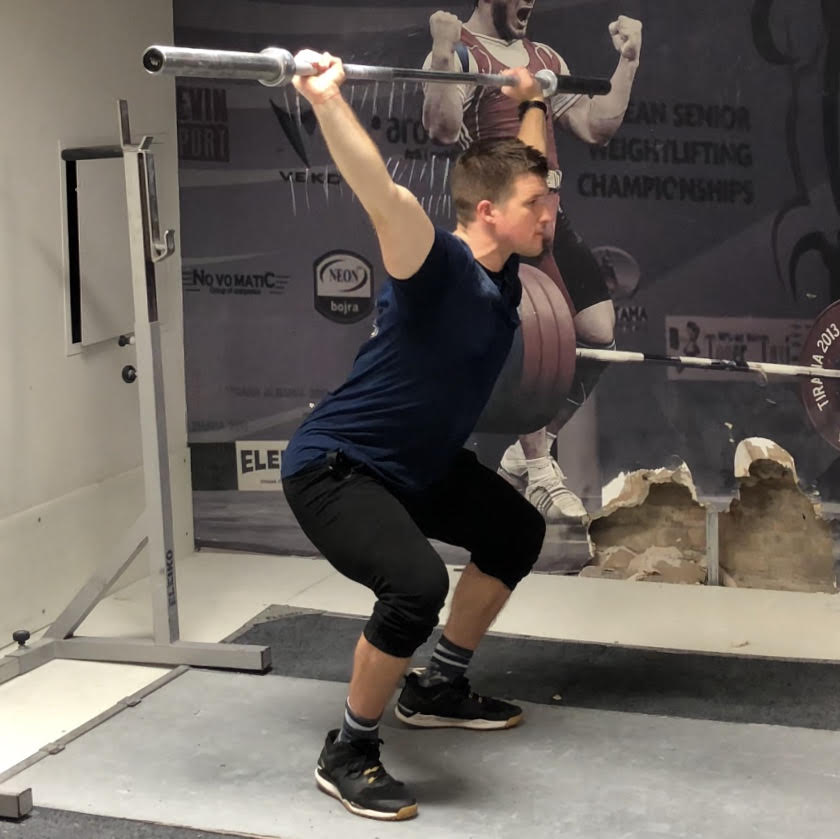
2.
Begin Descent
As you begin to descend, be sure not to extend the lumbar spine, but rather keep the core braced and the hips neutral (as opposed to anterior or posterior tilting of the pelvis).
This squat should be patterned in the same manner a high bar back squat would.
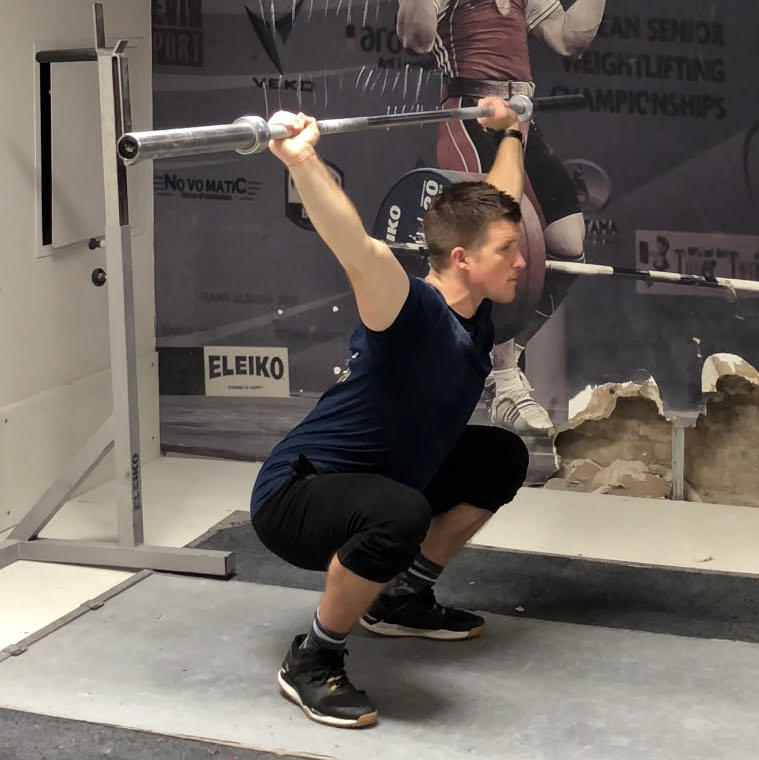
3.
Maintain Control and Position
Once you have reached full depth (which can be slightly different for everyone), the hip crease should be slightly below the knees, with the full foot down.
The lifter should keep the core tight and be sure to actively push against the barbell to keep it into the correct positioning overhead (see step one).
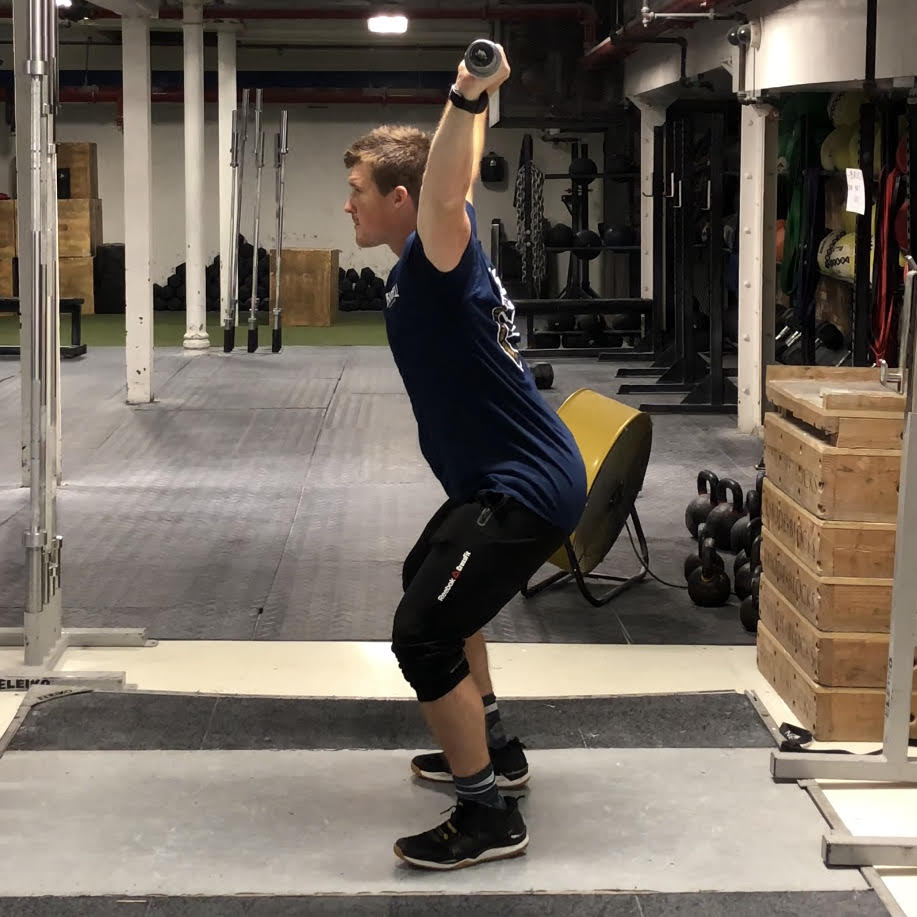
4.
Drive Up and Stand
From here, work to keep the barbell overhead and the chest up as you ascend out of the squat.
Be sure to keep the core tight and actively push up against the barbell to aid in standing up from the overhead squat.
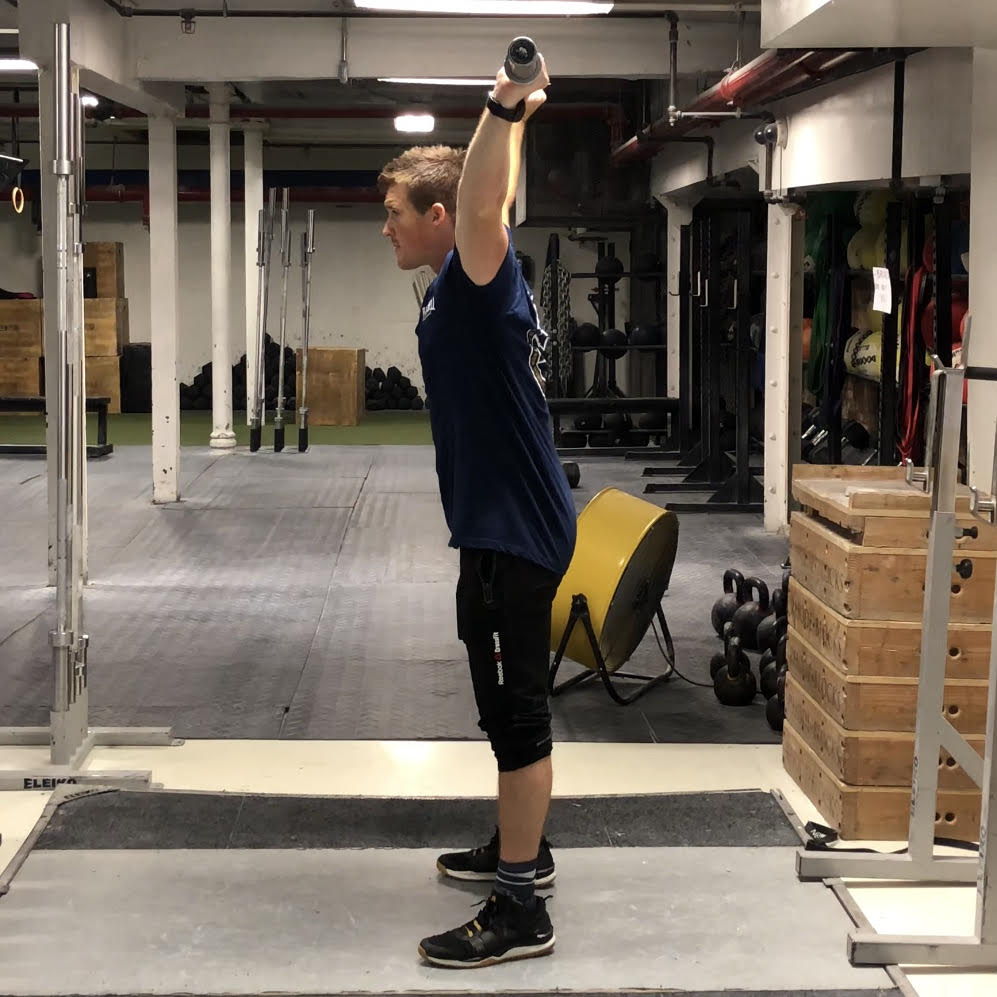
5.
Stabilize and Repeat
Once you have fully extended the knees and hips, stabilize the core and shoulders and repeat for repetitions.
Be sure to keep the upper back and shoulders stable by actively pressing upwards through the barbell.
Want More Snatch Training Tips?
Take a look at these top snatch training articles for more tips and programming notes to address common errors in the snatch!